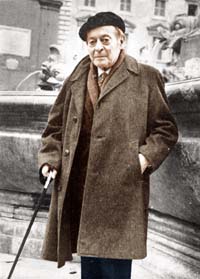Mario Praz facts for kids
Mario Praz (born September 6, 1896, in Rome; died March 23, 1982, in Rome) was an Italian expert in art and literature. He was also a well-known scholar of English literature. His most famous book, The Romantic Agony (published in 1933), explored dark and intense themes in European writing from the late 1700s and 1800s. The book was first written in Italian in 1930.
Contents
Biography
Mario Praz's father, Luciano Praz, worked at a bank and passed away in 1900. His mother, Giulia Testa di Marsciano, later married Carlo Targioni, a doctor.
Praz studied at the University of Bologna from 1914 to 1915. He earned a law degree from the University of Rome in 1918. Later, he received a doctorate in literature from the University of Florence in 1920.
In 1934, Mario Praz married Vivyan Leonora Eyles. She was a lecturer in English literature at the University of Liverpool. They had one daughter, Lucia Praz, born in 1938.
Today, Praz's former home in Palazzo Primoli in Rome is a museum called the Museo Mario Praz. The famous writer Orhan Pamuk once called it "the most magnificent writer's museum I had seen."
Life and Writings
Mario Praz was a respected Italian art critic and a scholar of the English language. He taught Italian Studies at the Victoria University of Manchester from 1932 to 1934. After that, he taught English Literature at the University of Rome from 1934 until he retired in 1966.
In 1962, Queen Elizabeth II honored him by making him a Knight Commander of the Order of the British Empire (KBE). This is a very special award.
While Praz is best known for his work in English literature, he also made big contributions to how we understand interior design and decoration. His ideas from The Romantic Agony influenced his writings on design and art.
Praz used this writing style in two important design books: The House of Life and An Illustrated History of Interior Design. These books explore his ideas about how a space feels inside. They also show how people make a space their own. His important book Studies in Seventeenth-Century Imagery (first published in 1939) was one of the first to study and list early modern emblems and personal devices. These were like symbolic pictures with meanings.
Design Writings
Mario Praz had a big impact on how people write about interior design and its history. His book, An Illustrated History of Interior Decoration from Pompeii to Art Nouveau, became like a photo album of design. It helped people rediscover this interesting art form.
His work shows pictures of homes from ancient Greece all the way to the Art Nouveau period. It includes comments on them. The images show the inside of Greek, Roman, Medieval, Renaissance, and Victorian homes in Europe. They capture details like carpets, furniture, pictures, fabrics, wall colors, curtains, and lighting. Praz carefully documented all these features. This helped create a new way to record the history of interior spaces.
Praz also changed how interior design has been studied since the mid-1900s. He helped grow the study of design history. His book, An Illustrated History of Interior Decoration, combines art history with ideas about how objects fill a space.
Praz was one of the first experts to connect art history with the inside of a room. He was also one of the first to notice that furniture shows who a person is. He wrote that "furnishings are tangible artifacts of social history." Praz believed that a house and its inside are always changing and need to be furnished. He thought that furniture, the home, and the interior all show the "character or the personality of the occupant." Praz showed how people completely influence how their house looks inside. His own book, The House of Life, shows this idea in his own home.
The House of Life is a great way to understand how an interior can show a person's personality. In this book, Praz describes his own apartment in Rome, where he lived for 30 years. He goes "room by room," sharing stories about his furniture and what it meant to him. This detailed account lets readers explore his home. It helps them understand his world through his eyes. His writing shows how he used and lived in his space. This detailed way of writing has been copied by other design writers.
The idea of horror vacui (meaning "fear of empty space") in art is linked to Praz. He used this term to describe very cluttered interior designs.
Critical Views on Design Writing
People had different opinions about Praz's design work. For example, Edmund Wilson called Praz's work a "masterpiece." However, Cyril Connolly said The House of Life was "one of the most boring books I have ever read."
Critical Views
Mario Praz was highly admired in Italy and other countries. Edmund Wilson, in his writing "The Genie of the Via Giulia," said that Praz "will come to be known to posterity—so far as a foreigner can judge—as one of the best Italian writers of his time."
See also
 In Spanish: Mario Praz para niños
In Spanish: Mario Praz para niños


